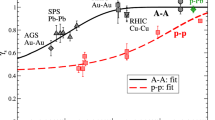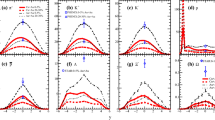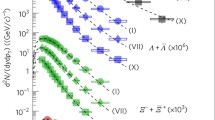Abstract.
Boost-invariant hadron production in high-energy collisions occurs in causally disconnected regions of finite space-time size. As a result, globally conserved quantum numbers (charge, strangeness, baryon number) are conserved locally in spatially restricted correlation clusters. Their size is determined by two time scales: the equilibration time specifying the formation of a quark-gluon plasma, and the hadronization time, specifying the onset of confinement. The expected values for these scales provide the theoretical basis for the suppression observed for strangeness production in elementary interactions (pp , \( e^+e^-\) below LHC energies. In contrast, the space-time superposition of individual collisions in high-energy heavy-ion interactions leads to higher energy densities, resulting in much later hadronization and hence much larger hadronization volumes. This largely removes the causality constraints and results in an ideal hadronic resonance gas in full chemical equilibrium. In the present paper, we determine the collision energies needed for that; we also estimate when pp collisions reach comparable hadronization volumes and thus determine when strangeness suppression should disappear there as well.
Similar content being viewed by others
References
B. Mueller, J. Rafelski, Phys. Rev. Lett. 48, 1066 (1982)
T. Matsui, H. Satz, Phys. Lett. B 187, 416 (1986)
J.D. Bjorken, Fermilab-Pub-82/59-THY (1982) and Erratum
M. Gyulassy, X.-N. Wang, Nucl. Phys. B 420, 583 (1994)
J.S. Hamieh, K. Redlich, A. Tounsi, Phys. Lett. B 486, 61 (2000)
F. Becattini, G. Passaleva, Eur. Phys. J. C 23, 551 (2002)
P. Castorina, H. Satz, Int. J. Mod. Phys. E 23, 1450019 (2014)
HotQCD Collaboration (A. Bazavov et al.), Phys. Rev. D 90, 094503 (2014)
F. Karsch, private communication
J.D. Bjorken, Phys. Rev. D 27, 140 (1983)
ALICE Collaboration (K. Aamodt et al.), Phys. Rev. Lett. 105, 252301 (2010) arXiv:1011.3916 [nucl-ex]
I. Kraus et al., J. Phys. G 37, 09421 (2010)
J. Letessier, J. Rafelski, A. Tounsi, Phys. Rev. C 64, 406 (1994)
J. Manninen, F. Becattini, M. Gazdzicki, Phys. Rev. C 73, 044905 (2006)
ALICE Collaboration (L. Bianchi), report at Quark Matter 2015, Kobe, Japan, to be published in Nucl. Phys. A
M. Floris, J. Phys. Conf. Ser. 668, 012013 (2016)
P. Castorina, S. Plumari, H. Satz, Universal Strangeness Production in Hadronic and Nuclear Collisions, arXiv:1603.06529, to be published in Int. J. Mod. Phys. E
Author information
Authors and Affiliations
Corresponding author
Additional information
Communicated by G. Torrieri
Rights and permissions
About this article
Cite this article
Castorina, P., Satz, H. Strangeness production in AA and pp collisions. Eur. Phys. J. A 52, 200 (2016). https://doi.org/10.1140/epja/i2016-16200-5
Received:
Revised:
Accepted:
Published:
DOI: https://doi.org/10.1140/epja/i2016-16200-5




